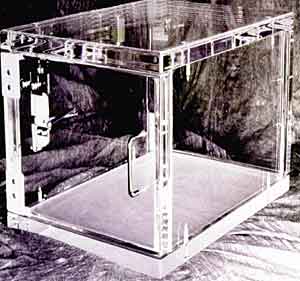Designing Bullet Resistant Protection Panel Systems: Capture More than the Imagination
Opaque Bullet Resisting Materials
Opaque materials are used in areas that are not transparent such as cabinets, under counters and walls. The most commonly used opaque materials are steel and fiberglass.
 |
| Interlock Package Exchange Photo credit: Bullet Guard |
Steel
UL-752 requires that steel be at least 3/16" open-hearth plate to meet Level 1. There is hardened steel available in higher Levels with UL-752 certification. Steel is very heavy and unless certified its results are unknown. 1/8" or 10 gauge steel does NOT meet UL -752 standards and has no consistency of thickness; it is a cold roll made of old cars and
tin cans.
Various Bullet Resistant Clear (Transparent) Materials
- Acrylic: Bullet resistant acrylic comes in sheet form and can be cut to size for custom applications. Acrylic is a ricochet product. It is available in UL-752 level I and II ratings.
- Acrylic-AR: Same as acrylic with an abrasion resistant coating. This coating is typically silicone based.
- Polycarbonate: Bullet resistant polycarbonate comes in sheet form and can be cut to size for custom applications. It is a laminated product with multiple layers of polycarbonate. Polycarbonate is a non-ricochet product. It is available in UL-752 Levels I through III. All bullet resistant polycarbonate laminates have an abrasion resistant coating on the outside sheets.
- Glassclad Polycarbonate: Glass clad polycarbonate is a mixture of glass and polycarbonate layers and is laminated together. It is made to order in specific size. Though not impossible it is impractical to try to cut it after it is laminated. Glass clad polycarbonates come in various levels of protection including UL-752 Level I through VIII. (1 through 8).
Fiberglass for Strength and Durability
UL Listed Bullet Resistant Fiberglass Panels are the most specified barrier panels. When given the important task of specifying an anti-ballistic design, it is very important that designers understand some basics about bullet resistant fiberglass panels.
A key question to be answered for ballistic design should be the most obvious; what is the threat level? Within the UL-752 Standard for Bullet Resisting Equipment the 8 threat levels defined earlier govern. Typically the threat level can be determined for any geographic area by consulting with crime statistics kept by local police authorities or by national records kept by the Justice Department. Sometimes the facility owner or facility administrator will have already determined what they believe the threat level to be and provide input for the designer to use a higher-level material. Also, when specifying bullet resistant fiberglass it is important to avoid specifying a panel thickness rather than a UL-752 threat level. Always specify the UL-752 threat level to be defeated since panel thick nesses may vary from one manufacturer to another.
Bullet resistive fiberglass is usually a multi-ply laminate made of woven roving "e-glass" that has been mechanically impregnated with a resin matrix. Industry experience also shows epoxy-based resin systems should be avoided, as they tend to create a highly rigid panel that does not delaminate well. Good delamination of the various plies of fiberglass is the key to defeating the kinetic energy of the projectile. Polyester resins that have been thermo set (cured) under heat and pressure will provide the best delamination.
 |
 |
| Fixed Counter Enclosure with Interlock Package Exchange
and Continuous Voice Port Photo credit: Bullet Guard |









